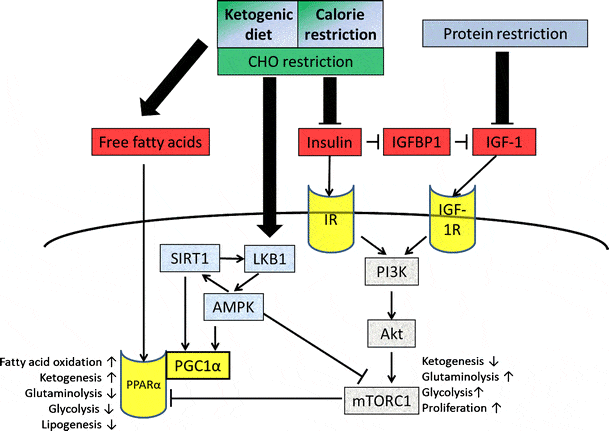
Calorie restriction (CR) and a ketogenic diet (KD) target the same molecular pathways that are also targeted individually by drugs to improve cancer treatment outcomes. Arrows indicate activation, truncated lines inhibition. Carbohydrate (CHO) restriction up-regulates fatty acid oxidation and ketogenesis (beneficial for normal tissues) and impairs glycolysis and glutaminolysis (detrimental to tumor cells). Full study here.
Health Impact News Editor Comments:
One of the truly exciting new frontiers in nutrition therapy is the study of the high-fat low-carb ketogenic diet, especially in relation to preventing and curing cancer. The ketogenic diet as a therapeutic diet is not new. It has been around at least since the 1920s, when researchers at John Hopkins discovered that the diet could cure some children from epileptic seizures where drugs had failed.
In 2013 we published a few stories highlighting new research showing the ketogenic diet’s value to cancer patients:
Study: Ketogenic Diet and Hyperbaric Oxygen Therapy Stops Cancer
Ketogenic Diet in Combination with Calorie Restriction and Hyperbaric Treatment Offer New Hope in Quest for Non-Toxic Cancer Treatment
The Benefits of a Ketogenic Diet and its Role in Cancer Treatment
Using the Ketogenic Diet to Heal Brain Tumors
Starving Cancer: The High-fat Ketogenic Diet
Many of these studies are looking at not only the ketogenic diet, but also the concept of intermittent fasting or calorie restriction. These are beneficial aspects to study, as generally they cannot be mimicked by drugs.
There are indications that the way the ketogenic diet produces “ketones”, or the “ketogenic effect”, is being studied in order to produce pharmaceutical products (drugs or vaccines) that can mimic the same effect. With years of experience now documented in using the ketogenic diet with children suffering from seizures, one of the most common complaints is that the diet is difficult to adhere to, as the child has to abstain from refined carbohydrates and typical childhood sweets such as cakes and candies. The reasoning is that a drug would make life more bearable instead of following such a strict diet.
I am very encouraged by this recent study, published in January 2014, looking at the ketogenic diet and intermittent fasting as an adjunct nutritional therapy to be administered to cancer patients undergoing standard radiation therapy in cancer treatment. The study provides “dietary interventions” to be used along side “radiotherapy”. Therefore, this is not really a study that lends itself to developing more pharmaceutical drugs. However, will physicians in the allopathic medical field seriously consider rigorous diet therapy?
Of course, there are plenty of cancer therapies that are effective and non-toxic, but they are not covered by insurance companies in the U.S., and most of them are not approved by the FDA, so one must go south of the border into Mexico or travel to another country to receive the best non-toxic cancer therapies. (See: Cancer – The Forbidden Cures and Why Medicine Won’t Allow Cancer to Be Cured)
Calories, carbohydrates, and cancer therapy with radiation: exploiting the five R’s through dietary manipulation
Cancer and Metastasis Reviews
January 2014
Abstract
Aggressive tumors typically demonstrate a high glycolytic rate, which results in resistance to radiation therapy and cancer progression via several molecular and physiologic mechanisms. Intriguingly, many of these mechanisms utilize the same molecular pathways that are altered through calorie and/or carbohydrate restriction. Furthermore, poorer prognosis in cancer patients who display a glycolytic phenotype characterized by metabolic alterations, such as obesity and diabetes, is now well established, providing another link between metabolic pathways and cancer progression. We review the possible roles for calorie restriction (CR) and very low carbohydrate ketogenic diets (KDs) in modulating the five R’s of radiotherapy to improve the therapeutic window between tumor control and normal tissue complication probability. Important mechanisms we discuss include (1) improved DNA repair in normal, but not tumor cells; (2) inhibition of tumor cell repopulation through modulation of the PI3K–Akt–mTORC1 pathway downstream of insulin and IGF1; (3) redistribution of normal cells into more radioresistant phases of the cell cycle; (4) normalization of the tumor vasculature by targeting hypoxia-inducible factor-1α downstream of the PI3K–Akt–mTOR pathway; (5) increasing the intrinsic radioresistance of normal cells through ketone bodies but decreasing that of tumor cells by targeting glycolysis. These mechanisms are discussed in the framework of animal and human studies, taking into account the commonalities and differences between CR and KDs. We conclude that CR and KDs may act synergistically with radiation therapy for the treatment of cancer patients and provide some guidelines for implementing these dietary interventions into clinical practice.
Purchase the DVD – Free Shipping Available! Click image to view the trailer.




 How the Simple High-Fat Low-Carb Ketogenic Diet Continues to Change People's Lives
How the Simple High-Fat Low-Carb Ketogenic Diet Continues to Change People's Lives New Studies Continue to Show that Coconut Oil is the Best Oil for Treating Skin Conditions and Maintaining Healthy Skin and Teeth
New Studies Continue to Show that Coconut Oil is the Best Oil for Treating Skin Conditions and Maintaining Healthy Skin and Teeth New Study Confirms Health Benefits of Coconut Oil and USDA False Claims Against It
New Study Confirms Health Benefits of Coconut Oil and USDA False Claims Against It The FDA has NOT Banned Trans Fats! Traditional Saturated Fats like Coconut Oil Continue to Shine for Alzheimer's Disease but are Condemned by U.S. Dietary Advice
The FDA has NOT Banned Trans Fats! Traditional Saturated Fats like Coconut Oil Continue to Shine for Alzheimer's Disease but are Condemned by U.S. Dietary Advice The Evidence of Coconut Oil's Superiority Over Drugs in Destroying Pathogens Continues to be Published in Peer-Reviewed Journals
The Evidence of Coconut Oil's Superiority Over Drugs in Destroying Pathogens Continues to be Published in Peer-Reviewed Journals